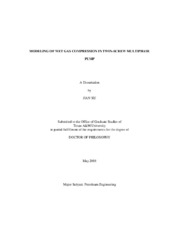| dc.description.abstract | Twin-screw multiphase pumps experience a severe decrease in efficiency, even
the breakdown of pumping function, when operating under wet gas conditions.
Additionally, field operations have revealed significant vibration and thermal issues
which can lead to damage of the pump internals and expensive repairs and maintenance.
There are limited models simulating the performance of twin-screw pump under these
conditions. This project develops a pump-user oriented simulator to model the
performance of twin-screw pumps under wet gas conditions. Experimental testing is
conducted to verify the simulation results. Based on the simulations, an innovative
solution is presented to improve the efficiency and prevent the breakdown of pumping
function.
A new model is developed based upon a previous Texas A&M twin-screw pump
model. In this model, both the gas slip and liquid slip in the pump clearances are
simulated. The mechanical model is coupled with a thermodynamic model to predict the
pressure and temperature distribution along the screws. The comparison of experimental data and the predictions of both isothermal and non-isothermal models show a better
match than previous models with Gas Volume Fraction (GVF) 95% and 98%.
Compatible with the previous Texas A&M twin-screw pump model, this model can be
used to simulate the twin-screw pump performance with GVF from 0% to 99%.
Based on the effect of liquid viscosity, a novel solution is investigated with the
newly developed model to improve the efficiency and reliability of twin-screw pump
performance with GVF higher than 94%. The solution is to inject high viscosity liquid
directly into the twin-screw pump. After the simulations of several different scenarios
with various liquid injection rates and injection positions, we conclude that the
volumetric efficiency increases with increasing liquid viscosity and injecting liquid in
the suction is suggested. | en |


